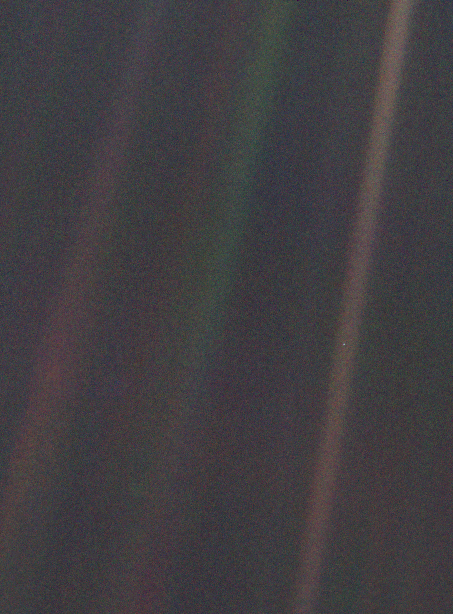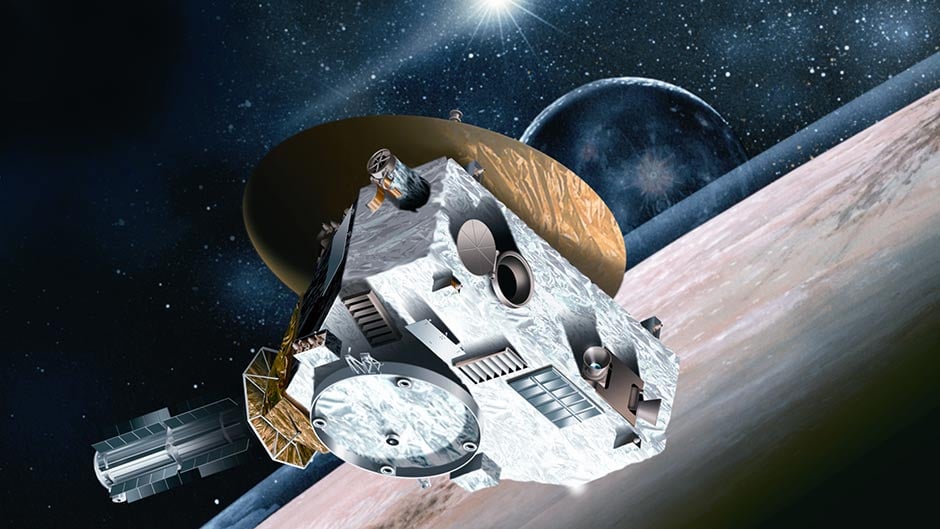At the very end of 1985 I was helping my parents make Christmas pudding. No-one makes pudding quite like our family. In the years between Voyager 2 and New Horizons, what started as a recipe from a very old copy of Maura Laverty's "Full and Plenty" has been tweaked and refined over into the Smyth Family Christmas Pudding. The year 1985 was the first year I remember being old enough to help make it. As we were weighing out dried fruit and beating eggs, the television was on and we were watching Carl Sagan explain the very first up-close pictures ever taken of the swirling, banded clouds and delicate, tilted rings of Uranus. I had never seen anything so mysteriously beautiful. No-one had ever seen this before.

The cameras of Voyager 1 on Feb. 14, 1990, pointed back toward the sun and took a series of pictures of the sun and the planets, making the first ever "portrait" of our solar system as seen from the outside. Image: NASA
Four years later Voyager 2 had made it to Neptune, and I was lucky enough to have a second chance to see the first close-up pictures ever taken of another planet. That year for Christmas my parents gave me an encyclopaedia of space. What were, at the time, the three outermost planets of our solar system - Uranus, Neptune, and Pluto - were covered on just one page, all the knowledge we had on them summarised in a handful of vague paragraphs. We knew so little. Within a few years, after the Voyager 2 data had been received, pawed over, and analysed, that encyclopaedia was already out of date. Voyager 2 taught us so much - it's incredible to think how much knowledge we gained from that one little probe.

Seen from about 6 billion kilometers, Earth appears as a tiny dot (the blueish-white speck approximately halfway down the brown band to the right) within the darkness of deep space. Image: NASA
The next year, in 1990, Voyager 2 sent us its last picture. It turned and looked back towards Earth, towards us, and it imaged what it saw from a staggering six billion kilometres away. It photographed Jupiter, the Earth, Venus, Saturn, Uranus and Neptune, and the Sun. Mercury and Mars were too close to the light of our star to be imaged from that distance, and Pluto - tiny, distant, yet-to-be-demoted Pluto - was too faint for Voyager to be able to see it. Everything was so tiny. Carl Sagan considered this Family Portrait of the Solar System to be one of the most important images mankind had taken because it showed us our place in the vast expanse of space, as just a tiny, pale blue dot glimmering faintly against the immense blackness, "a mote of dust suspended in a sunbeam".

If you are more than a couple of years younger than me you've never had the experience of seeing the very first images ever taken of another planet. It has been a long generation since we last sent a probe out into the far reaches of our solar system. Not that the science has been standing still; far from it. Ground- and space-based telescopy has let us count the stars of distant galaxies, find planets orbiting other suns, measure the unmistakable and energetic signs of black holes, and trace the fine mesh of the cosmic microwave background radiation that describes the history of our whole universe; but until today the least member of our family has been just a vague ball of uncertain size, unknown colour and invisible features.
But the New Horizons mission has changed that. Alan Stern, New Horizons' principal investigator, said: "We’re going to turn points of light into a planet and a system of moons before your eyes." And they have. For one thing we now know that Pluto, long assumed to be a dull grey colour like our moon, is in fact a dusky red hue. Pluto's own moon, Charon, assumed to be similar in composition and appearance to its very nearby neighbour, is in fact very different, lacking both Pluto's varied surface geology and its surprising colour. As Stern said: "They look as if they are completely different worlds ... They could as well have been raised billions of miles apart."
There are lots of reasons why the science of Pluto is important, and we'll talk about those in another post, but as Carl Sagan would have said were he still with us today, there is something even more significant than the science in the success of the New Horizons mission:
No person alive today on our blue-green marble will ever again see the surface of another world imaged for the very first time. Tweet this. 
Decades ago we set out to visit what we considered at the time to be every planet in our system. Whether it is technically a planet now, or whether it regains its planetary status once we get real data on it, Pluto is the last unvisited place in that great push out into our local space.
As of today we have sent a probe to visit every one of our solar relatives, even our most distant cousin Pluto. We know the surface of every rocky planet, the clouds of every gas giant. This is not where the science ends - there is so much more we can learn; but it is the last time for many, many generations that we, as a species, will visit another world for the very first time. But as our desire to explore and our quest for knowledge takes us further and further out into space, we remain fixed here on this one tiny sphere spinning through the vastness of our solar neighbourhood.

NASA's New Horizon spacecraft took off in 2006. Image: NASA
"It has been said that astronomy is a humbling and character-building experience. There is perhaps no better demonstration of the folly of human conceits than this distant image of our tiny world. To me, it underscores our responsibility to deal more kindly with one another and to preserve and cherish the pale blue dot, the only home we've ever known."
Carl Sagan, Pale Blue Dot: A Vision of the Human Future in Space, 1997
Are you mad about science? If you want to get ahead, connect to one of our expert Science Specialists now, for better marks tomorrow.



